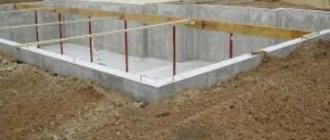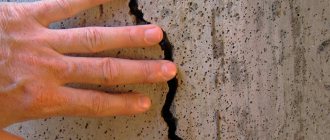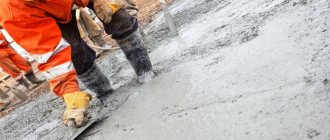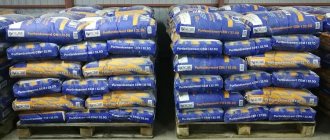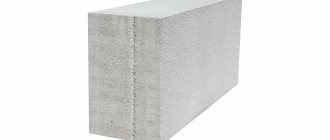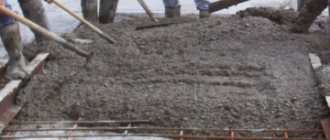Reinforced concrete sleepers
One of the options for fastening rails to wooden sleepers (SC) using a wood grouse (track screw).
This term has other meanings, see Sleeper (meanings).
Sleeper
(Dutch spalk - support) - support for rails in the form of beams or reinforced concrete products. In a railway track, sleepers are usually laid on the ballast layer of the upper structure of the track and ensure that the relative position of the rail threads remains constant, they receive pressure directly from the rails or from intermediate fastenings and transfer it to the undersleeper base (usually a ballast layer, in the subway - a concrete base).[1 ]
When laying the Liverpool - Manchester Railway, stone slabs were used to serve as the basis for laying the rails. Later, wooden sleepers appeared, and then other types of sleepers; Moreover, wood was the most common material for sleepers for a long time[2].
Wooden sleepers
Used wooden sleepers
The type of wood for sleepers can be different (for example, red maple or eucalyptus), in some countries oak is preferred [3], and in some, for economic reasons, softwood, mainly pine, although such sleepers are more subject to wear[3]. To prevent rotting, sleepers are impregnated with antiseptics, most often creosote.
Wooden sleepers have many advantages: elasticity, ease of processing, high dielectric properties, good adhesion to crushed stone ballast, low sensitivity to temperature fluctuations [2]. The most important property is the possibility of widening the rail gauge in curves with a radius of less than 350 m[2].
The service life of wooden sleepers (depending on the type of wood, external conditions and intensity of use) ranges from seven to forty years. Wooden sleepers in Russia are made primarily from pine, as well as spruce, fir, and Siberian cedar[2], although earlier experiments were conducted on making sleepers from oak and larch. The main problem of wooden sleepers is the tendency for them to rot in the places where rails are attached to them, and the problem with their further disposal.
Wooden sleepers are manufactured in accordance with GOST 78-2004.
- Type 1 sleeper, impregnated - used for main tracks
- Sleeper type 2, impregnated - used for access and station tracks
Wooden sleepers are divided into three types:
- edged (hewn on all four sides)
- semi-edged (hewn only on three sides)
- unedged (hewn only on top and bottom)
Previously, a dexel ax (adze) was used to cut sleepers.
Impregnation of wooden sleepers
See also: Sleeper impregnation plant
Impregnation of sleepers is carried out with coal oils, creosote, or ZhTK antiseptics for impregnation of railway sleepers. Currently in Russia, impregnation is carried out using the “vacuum-pressure-vacuum” method; this method is standardized by GOST.
- Sleepers before impregnation
- Autoclave lid
- Impregnated sleepers
- Car loaded with impregnated sleepers
To impregnate sleepers, manufacturers use a range of equipment: autoclaves, drying chambers, steam generator boilers, etc.
Impregnation of wood using the “vacuum-pressure-vacuum” method ensures the deepest penetration of the protective agent and is used for impregnation of wood used in difficult conditions: sleepers, power transmission line supports, piles, bridges, etc. The wood must be dry or dried immediately before impregnation, including or autoclave.
Types of products
Reinforced concrete sleepers come in different types, more details about which are in the table:
| Classification options | View | Characteristic |
| Resistance to cracking, quality and accuracy of parameters | 1st grade supports | Has high performance characteristics |
| 2nd grade supports | Subject to cracking, deviations in dimensional geometry are allowed | |
| Type of fastening to flights | Ш-1 | Separate bolt-clamp connection, fixation is carried out with bolts and gaskets |
| Sh-2 | Separate fastening | |
| Sh-3 | Similar to Sh-2, but the type of fastening is different | |
| Availability of insulation from electric current and type of reinforcement frame | With insulation | Concrete sleepers are equipped with insulators |
| Without insulation | No insulating liners |
Reinforced concrete sleepers
Reinforced concrete sleepers after removal from the mold.
In some cases, instead of sleepers, solid block foundations in the form of slabs or frames made of reinforced concrete or metal are used.
Since the 1970s, sleepers made of prestressed reinforced concrete have gained popularity in the USSR; their use has been especially successful on continuous-joint tracks.
Reinforced concrete sleepers are reinforced concrete beams of variable cross-section. On such beams there are platforms for installing rails, as well as holes for rail and sleeper fastening bolts (when driving wooden plugs into the holes, crutches and screw connections are also used). Reinforced concrete sleepers are made with pre-tensioned reinforcement. The manufacturing technology of reinforced concrete sleepers is as follows: reinforcement strings are placed in a special mold, tension is applied to them (depending on the purpose of the sleeper, usually 180 atm), the mold is filled with concrete and compacted by vibration. Then the form is disassembled and sent to a steaming chamber, where the concrete hardens, after which the tension from the strings is transferred to the concrete and the form is turned over (turned over). This method of making sleepers gives them elasticity and protects the sleeper from splitting under the rolling stock.
Advantages of reinforced concrete sleepers: practically unlimited service life due to high mechanical strength and resistance to rotting, which makes it possible to reuse sleepers, as well as use them on heavily loaded sections of the track. Disadvantages: insufficient rigidity, high cost and weight, possibility of fatigue failure of concrete.[2].
Recently, anchor connections have been increasingly used to fasten rails and reinforced concrete sleepers [ source not specified 1685 days
].
Reinforced concrete sleepers: main types, characteristics and application features
In this article we will talk about what these products are, as well as the features of their production and operation. Let's consider where used reinforced concrete sleepers are used, and what requirements are imposed on manufacturers of this type of material.
Initially, stone blocks were placed under the railway rails. A little later, stone was replaced with wood, which not only had better shock-absorbing qualities, but was also easier to machine. However, the situation changed dramatically only when the production of reinforced concrete sleepers began.
Ready-to-install sleepers
A little history
In the photo - wooden sleepers after long-term use
As already mentioned, the history of railways includes several types of supports that are placed under the rails. All solutions had a number of operational shortcomings. For example, the stone was extremely difficult to process and had low shock-absorbing properties.
In addition, despite their apparent strength, these slabs were not the most durable solution, since due to prolonged mechanical exposure they cracked and became partially or completely unusable.
The situation was slightly better with wood products. Such sleepers were tarred to protect against the negative effects of environmental factors. But wood, sooner or later, despite special treatment, rots. And, as a result, the railway tracks require repairs.
Despite the good shock-absorbing properties, wood has one significant drawback - the high price of lumber, even taking into account the ease of their mechanical processing. The situation changed for the better in the second half of the twentieth century when the first reinforced concrete sleepers were developed.
Despite the fact that wooden products are still used on secondary branches, it is reinforced concrete structures that are rightfully considered the most modern and promising solution.
Main characteristics
Scheme and dimensions of reinforced concrete sleepers Ш1
The instructions for using reinforced concrete sleepers in the post-Soviet space have been tested for more than 40 years.
In accordance with GOST 23009, modern concrete sleepers are rail supports made in the form of beams with variable size and cross-sectional shape. The product is reinforced with reinforcing wire with a cross-sectional diameter of 3-6 mm, depending on the modification.
During operation, the product is laid on top of the ballast layer. In relation to conventional tracks, large-sized crushed stone is used as a ballast embankment, and when arranging the subway, a slab-type concrete base is used.
Schematic representation of reinforced concrete products type Sh1
Products made of prestressed reinforced concrete, used as under-rail supports, are the optimal solution for both continuous and other categories of tracks.
The relevance of these designs is explained by a number of technical and operational advantages, including:
- long service life;
- optimal indicators of resistance to the negative effects of environmental factors;
- resistance to mechanical loads;
- non-susceptibility to rotting throughout the entire service life;
- Possibility of installation on tracks with any level of congestion;
- relatively low price;
- minimum costs required for operational maintenance;
- ease of installation and installation, in comparison with wooden analogues;
- absolute identity of standard sizes, shapes and weights, which guarantees ease of transportation and shipment.
In the photo - tongs for carrying sleepers
Are there any disadvantages that could negatively affect the use of these concrete products?
There are few such disadvantages:
- Firstly, there is the possibility of fatigue failure of the concrete structure and, as a consequence, the need for periodic inspection of the tracks.
- Secondly, the weight of the reinforced concrete sleeper (270 kg) makes it impossible to install it yourself without the use of special equipment. Therefore, unlike wooden analogues, concrete structures are installed using specialized sleeper layers.
Scope and conditions of application
Schematic representation of reinforced concrete sleepers type Ш3 and Ш3Д
Sleepers made using prestressed concrete are widely used in the construction of railway transport links around the world.
Considering the variety of climatic conditions in which these products are operated, as well as the varying degrees of mechanical loads, increased demands are placed on the production of sleepers, as well as on the quality of the finished product. As a result, depending on the favorable conditions of use, these reinforced concrete products can be used in for 30-60 years.
Reinforced concrete sleepers for laying travel paths for rail cranes
The widespread replacement of conventional wooden supports with reinforced concrete analogues is explained not only by strength and durability, but also by short production times.
For example, the production of ready-to-install concrete products requires only a few hours, which is very convenient when we are talking about the construction of a large branch and the constant supply of large volumes of building materials is required. Again, concrete products can be repaired and adapted for operational needs using diamond drilling of holes in concrete.
Important: Sleepers manufactured by domestic manufacturers using prestressed reinforced concrete in accordance with GOST requirements are superior to their foreign counterparts in terms of load-bearing capacity and material consumption.
Requirements for railway reinforced concrete sleepers
Installation of rails and reinforced concrete sleepers before laying on the embankment
As already mentioned, the operating conditions in which sleepers are used place high demands on the production technology of these reinforced concrete products and, in particular, on the production technology of prestressed reinforced concrete.
The following requirements apply to the material and the finished product:
- Strength sufficient to transfer the prestressing force within a few hours (the time is set in accordance with the modification of the concrete products) at the end of the production process.
- The maximum possible degree of homogeneity of the consistency of freshly prepared concrete.
- The accuracy of dimensions and shapes is an order of magnitude higher than similar requirements for other categories of commonly used reinforced concrete and prestressed reinforced concrete structures. These requirements mean tolerances on the angle of inclination, length and width of individual structural elements. The dimensions in areas adjacent to the rails are especially strictly controlled.
Important: In Western Europe, the technical requirements that determine the quality of the source material used in the manufacture of reinforced concrete sleepers are regulated by the EN 13230 standard. The strength class of the source material in domestic production is determined by the higher requirements given in GOST 26633.
Manufacturing technologies
Forms for pouring concrete with rods to transfer prestress
Regardless of whether the foundation is planned to be made of reinforced concrete sleepers or the reinforced concrete products will be used for their intended purpose, the strength of these structural elements will be guaranteed. The performance qualities of finished products are ensured by production technologies.
Despite the fact that many sleeper manufacturing methods have been tested over the course of more than fifty years, today the four most common production technologies that meet the requirements of international standards are widely used.
- Carousel technology with delayed mold removal.
The peculiarity of this technological process is that the finished mixture is poured into molds and compacted. Removal of the product from the mold is carried out only after achieving optimal strength indicators sufficient to apply a prestressing force. During the manufacturing process, specialized collapsible cassette molds are used, which can accommodate up to six units of the product. Through the use of special tension mechanisms, pre-stressing of the reinforcing bars is ensured, which is subsequently transferred to the concrete and ensures optimal adhesion to it. Once the reinforced concrete sleeper is ready, the mold can be dismantled and immediately used for the next production cycle. The name of the method is explained by the type of production process and the design features of the molds used, which are located on a carousel-type transport system. This method has become widespread in Western European countries and is considered the most promising and technologically advanced. - Linear technology.
No matter whether the reinforced concrete half sleeper for rail cranes or a full-size product is manufactured, the production process can be realized based on linear technology. The production process uses a conveyor with a series of molds arranged in series. The total length of the chain is usually at least 100 meters. At the ends of the molds, special devices are used that not only close the mold, but also transfer pre-stress to the reinforcing bars. As the mixture dries, the force is transferred to the concrete. - Technology of mold removal with subsequent tension.
In the photo - a modern line for the production of sleepers of Western European standard
In this case, templates are inserted into the forms, which will determine the location of the metal reinforcement. The concrete is then poured into the molds and compacted.
As it hardens, metal pins are inserted into the thickness of the mixture and applied mechanical force. After a short period of time, the mold is dismantled and the templates are removed. The advantage of this method is that the process is essentially continuous, and therefore a limited number of forms are needed to obtain the desired result.
- Technology of mold removal with pre-stressing. In this case, the form is removed as quickly as in the previous method. The only significant difference between this technological process is that the tensile force is transmitted to the product not through pins, but through frames.
Features of installation, repair and disposal of reinforced concrete sleepers
The photo shows the operation of a mobile sleeper
Laying railway tracks using reinforced concrete sleepers has a number of characteristic features.
Rails and concrete sleepers, during the construction of railways, are mounted on an initially prepared roadbed based on earth soil, sand and crushed stone backfill. In order to prevent damage to the sleepers during the passage of trains and ensure the safety of the roadbed, special preparation is required, which consists of installing sand strips .
Laying is carried out using mechanized systems that minimize the use of physical labor. As a result, the cost of the installation process is reduced, and in addition, the implementation time for laying the track as a whole is reduced.
As previously mentioned, the service life of reinforced concrete sleepers is limited to 30-60 years. But such durability parameters are only possible if the condition of the tracks is regularly inspected for breakages and partial deformations.
For example, the operational condition of reinforced concrete products is influenced by the condition of the screws securing the lining to the sleeper. If the screw is broken and the problem is not detected in a timely manner, there is a high probability that the lining will hit the concrete as it passes through, causing fatigue stresses in it. (See also the article Hardening of concrete: features.)
If the problem is not eliminated after the screw head comes off, in a relatively short period of time microcracks appear in the thickness of the concrete, which lead to partial or complete destruction of the sleeper.
The photo shows the work of a mechanized complex for recycling solid construction waste
At the end of their service life or due to natural destruction, sleepers must be replaced. At the same time, unusable concrete products must be disposed of.
Since cutting reinforced concrete with diamond wheels for the purpose of grinding seems to be an unreasonably expensive process, processing is carried out using special mechanized complexes. The main working element of the complex is a jaw crusher, which crushes reinforced concrete products to the consistency of medium or small-sized crushed stone. (See also the article Strengthening concrete: how to do it.)
Recycled sleepers can subsequently be used as materials for backfilling pits or for forming embankments.
Conclusion
Now you know how much a reinforced concrete sleeper weighs, how it is made and what its operational features are. We must assume that the use of these concrete products will be relevant and in demand for a long time.
Indeed, even despite the development of completely plastic sleepers in Japan, it is compliance with GOST for reinforced concrete sleepers that guarantees the optimal combination of strength, durability and reasonable cost. You can find more useful and interesting information by watching the video in this article.
rusbetonplus.ru
Steel sleepers
Steel sleepers
Steel sleepers are made from bent steel profiles and are relatively light in weight. Such sleepers are sometimes used for temporary access roads and branches of industrial enterprises. Their advantage is that they are not susceptible to rotting and insect attacks, and they maintain track width well, but the big disadvantage is that they are susceptible to corrosion.[4][5]
Steel sleepers are used on the railways of Morocco and Algeria[2]. As you know, these countries have a very dry climate (even on the coasts). In Saudi Arabia, where steel sleepers are also widely used, the main reason for their use was the constant theft of wooden sleepers by Bedouins for fires.
Metal sleepers are also used in blast furnace and steelmaking in those areas where, due to high temperatures, wooden sleepers burn, and concrete delamination occurs in reinforced concrete sleepers. In addition, metal sleepers make it possible to arrange the upper structure of the track with increased loads on the axle of rolling stock - up to 60 tons (axle loads on Russian Railways rolling stock up to 25 tons).[6].
In Russia, steel sleepers on the public railway network are used only in some sections of the Kaliningrad railway.
Reinforced concrete sleeper type Ш-1-1 | UkrMashService
We sell at competitive prices
reinforced concrete sleepers type sh-1-1
| Reinforced concrete sleeper type Ш-1-1 has the following characteristics: | ||
| Standard: | DSTU BV.2.6-57:2008 | |
| Length: | 2.7 m | |
| Width: | 0.305 m | |
| Height: | 0.229 m | |
| Concrete class: | IN | |
| Weight of one sleeper: | 270 kg | |
| Quantity in 1 ton: | 3.7 pcs | |
Reinforced concrete sleepers Ш-1-1 (grade 1) are used for separate terminal-bolt fastening of KB with bolted attachment of the lining to the sleeper. They are pre-stressed for 1520 gauge.
Reinforced concrete sleepers Ш-1-1 are used for broad gauge railways, manufactured in accordance with GOST 10629 - 88. On low-volume lines, the actual service life of reinforced concrete sleepers is 50 years. The angle of inclination of the thrust edges of the under-rail platforms in the sleepers is 55.
All sleepers we offer are new. If a contract is concluded, documents available from manufacturers confirming quality will be attached to it:
— Certificate of Ukr Sepro.
— Certificate ISO 9001 - 2001.
- Certificate of conformity.
RELATED PRODUCTS:
Lining KB-65
|
rails.com.ua
Characteristics of sleepers, laying sleepers
Track on wooden sleepers
The length of the sleepers depends on the width of the track. In Russia, reinforced concrete sleepers with a length of 270 centimeters and wooden sleepers with a length of 275, 280 or 300 centimeters are used. Under the turnouts, long types of sleepers are laid - turnout beams, the length of which reaches the length of two sleepers.
In some cases, instead of sleepers, solid block foundations in the form of slabs or frames made of reinforced concrete or metal are used.
The number of sleepers per kilometer of railway track is called the sleeper laying diagram
. This value in different countries ranges from 1000 to 2200 sleepers. Standard values for Russia are 2000, 1840, 1600 or 1440 sleepers/kilometer[1]. Basically, a diagram of 1840 pieces/km (46 sleepers per 25 meters) is used on straight sections and 2000 pieces/km in curves[7]. A lot of wood is consumed on wooden sleepers, but they, unlike reinforced concrete ones, soften shaking better; Most often used for tram tracks.
Sleepers in the subway
In the Moscow Metro, on closed sections of the track, block sleepers made of pine wood of types I and II, impregnated with creosote, are used. Reinforced concrete sleepers are used in open sections of lines. The length of the sleepers is 270 cm, the cross section is 16x25 centimeters. At metro turnouts, bars with a length of 270 to 675 cm are used. At stations, so-called “sleeper shorts” 90-100 cm long are used to create a safety trench.
In the first stage of the metro, 1,600 sleepers were laid on the straight section of the track, 1,760 on the curve, from the second to the fifth stage the number of sleepers was increased, amounting to 1,680 and 1,840, respectively. During the construction of the ground part of the Filyovskaya line, the number of sleepers was further increased and amounted to 1,840 and 2,000, respectively.
Notes
- ↑ 1 2 Sleeper
- article from the Great Soviet Encyclopedia. - ↑ 123456
Rail transport: Encyclopedia / Ch. ed. N. S. Konarev. - M.: Great Russian Encyclopedia, 1994. - 559 p.: ill. - ↑ 12
Hay 1982, pp. 437-438. - Hay 1982, p. 477.
- Grant 2005, p. 145.
- Metal sleepers https://metal4u.ru/articles/by_id/214
- Great Russian Encyclopedia: In 30 volumes / Chairman of scientific editor. Council Yu. S. Osipov. Rep. edited by S. L. Kravets. T. 9. Dynamics of the atmosphere - railway junction. - M.: Great Russian Encyclopedia, 2007. - 767 p.: ill.: map. (article Railway track)

